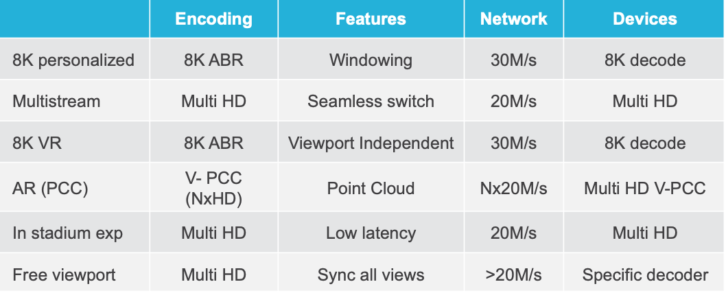5G is on track to reinvent the media industry, opening up new opportunities for better video experiences on mobile devices. But why 5G, and why now?
5G is a necessity to fix some of the limitations of 4G. With 4G, bandwidth served cannot always deliver high quality at scale due to zero rating restricting the quality to SD, especially in United States where this is common practice. Today, the application’s scale versus network speed is a constant challenge with 4G. There’s a huge elasticity of video resolutions demanding bandwidth from the network, from SD to 8K. While some applications can be supported by today’s 4G networks, when networks become congested many cannot be delivered. Additionally, the current deployed range of devices have limited processing capabilities, restricting the scope of applications.
5G offers dramatically increased mobile bandwidth. Depending on the source number at scale, we can expect at least a 10 times increase in bandwidth with 5G vs 4G, enabling next-generation, bandwidth-hungry applications such as HD or even UHD, multiview, AR, VR and low-latency video streaming. These applications promise to help video service providers attract new customers, increase ARPU and reduce churn.
With 5G, video content providers can test new business models fast since they have access to a more powerful network, edge Cloud-based architecture and Cloud-based processing capabilities that don’t exist with 4G.
5G Revenue Expectations, Trials and Service Deployments
5G networks will have a significant impact on media revenue. According to Intel, the global media industry stands to gain $765 billion in cumulative revenues from new services and applications enabled by 5G between 2016 and 2028.
Several video applications, in particular, stand to benefit greatly from 5G networks, including 8K personalised streaming services, multiview (for multicam or multigame), 8K VR, AR, and free viewport. Those experiences can be consumed in stadium thanks to 5G networking capacity and edge Cloud infrastructure that can host the processing for those applications onsite. By 2028, AR and VR are expected to capture the largest slice of media revenues enabled by 5G.
The APAC region has made the most progress on 5G deployments. In Korea, SKT, KT and LGU+ have already deployed VR applications in 5G networks. In addition, SK Telecom has successfully transmitted 8K video over 5G and are enabling multiview capabilities for live events and concerts, to where end-users can select the view they want to see.
LGU+ may be one of the most innovative examples of multiview service delivery over 5G. LGU+ offers a VR experience of live sports events. They are also immersed in delivering 8K personalised streaming where the user can navigate with a 5G 4K phone inside the capture (8K) content and free viewport services, moving inside the content in a 6DoF way, a one-of-a-kind experience.
In Europe and the US, there are a growing number of trials on 5G networks, mostly sports related, but no commercial deployments yet. At the French Tennis Open, Orange demonstrated a multiview transmission during a tennis match over 5G. Verizon similarly has demonstrated multiview applications, allowing end users to select from various views during football games. During those demonstrations, users were able to switch seamlessly from the broadcast view to single cam view, showcasing the power of 5G.
8K is an application that’s gaining a lot of attention for 5G. One of the most notable trials was during the 2019 French Tennis Open, where Harmonic joined France Télévisions, Fédération Française de Tennis (FFT), Orange and 18 other global technology partners to demonstrate the first ever delivery of live 8K video on 5G networks.
For advanced video delivery applications over 5G to succeed, the ecosystem needs to be fully developed. Overcoming limitations on the device side will be key, as most head-mounted displays for VR only support 4K. However, QUALCOMM recently announced its new XR2 reference design, which supports 8K VR video, which was followed by the Oculus release of the Quest 2 based on the XR2 platform. Those are major steps in the adoption of VR, as we see a major quality improvement vs. 4K content and devices.
Resources are Critical for 5G Video Service Delivery
As 5G networks are rolled out and expanded around the world, the future of advanced video delivery looks bright. But resources will be critical to enabling seamless delivery of video over 5G.

For 8K personalised video, operators need to be able to encode in 8K ABR. A windowing feature is required on the device side for decoding 8K video and delivering the content on the 4K screen. Most 5G phones can decode 8K, so we expect 8K VR adoption to be fast over 5G. In terms of network bandwidth, about 30 Mbps is necessary to deliver 8K personalised video.
Multistream video delivery over 5G requires multi-HD encoding on the service provider side.
For this application, seamless switching is essential from each view to ensure a high quality of experience for end users. About 20 Mbps is necessary, using HEVC for high-quality sports experiences, like those demonstrated by Harmonic and its partners at RG Lab 2020 with France television.
For 8K VR video applications, service providers need solutions capable of encoding in 8K ABR.
Infrastructure upgrades are underway as service providers look to commercially deploy 8K VR in the near future. 8K VR video needs to be viewport independent in order to ensure a seamless integration in the existing OTT video streaming workflow. From a bandwidth perspective, 8K VR video requires about 30 Mbps, and 8K decoding is now widely supported on 5G phones.
To support AR video delivery over 5G, developments are being made in the area of Point Cloud Compression (V-PCC), recently standardised by MPEG. This application requires volumetric capture of content in HD. Transmission of an HD object is achieved by mapping the object on different point Cloud views, which is then overlaid in AR on the device side that will reproduce a volumetric object at HD resolution. From a bandwidth perspective, V-PCC video requires between 8-22 Mbps per object. Penetration on 5G devices is natural, as multi-HD decoding is now widely supported on 5G phones.
Free viewport is the most complex video application for 5G and is still at an experimental level. It requires transmitting and decoding multiple HD objects, and we expect more than 100 Mbps from the network to support this application.
Conclusion
5G creates exciting new opportunities in several different domains, enabling 4K and 8K UHD experiences, multiview in HD, as well as high-quality immersive AR and VR video delivery. Thanks to the high capacity of 5G networks, service providers can deliver a high-quality experience for VR and AR applications, with low latency that will improve the user experience. Both features are missing with 4G. Leveraging the edge cloud architecture and network slicing features that are supported by 5G, service providers can also enable lower latency and more agile deployments at scale, which is critical for live sports events.
A significant amount of resources are required for delivering new video applications over 5G, with real-world deployments and trials showing what is achievable today. Harmonic’s VOS 360 Platform supports the 5G video applications discussed in this article, with a Cloud-native architecture capable of migrating at the edge of the network, when needed, leading the 5G revolution.







